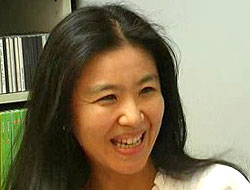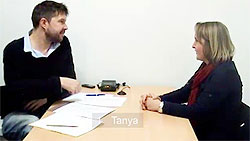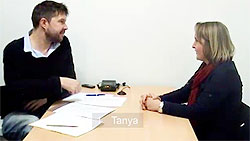
In this unit you will focus on the following:
- Greetings
- Common topics for Part 1
- Useful language for Part 1
- Identifying topics
- Adding information
- Relevant follow-up statements
- Describing habits, likes and dislikes
2. Greetings.
Listen to an examiner greeting a candidate at the start of the speaking test. Tick the expressions that you hear.

4. Common topics for Part 1.

TIP:
The examiner can ask you questions about various topics in Part 1. You should be prepared to talk about these, but do not prepare a speech for each part, as this will sound very false in the exam.Drag the correct heading to each category to complete the chart showing common topics and useful language areas for Part 1.
5. Common topics for Part 1.
Can you remember? Complete the three tables with the words and phrases.
6. Identifying topics.
Watch different candidates during Part 1 of the speaking test and identify which topic each candidate talks about.
Watch the videos again. Turn on and read the subtitles.

7. Vocabulary review.
Review vocabulary associated with the topics from the previous exercise. Put the words and phrases in the correct box. Use a dictionary if necessary. This exercise is in two parts.
Part 1
Drag to 3 boxes
Part 2
Drag to 3 boxes
8. Expanding on a topic.
TIP:
Try to avoid very short answers to the questions the examiner asks you. If you speak more you will give the examiner a better impression of your speaking abilities. Expanding on a topic is a good way of finding more to speak about and giving longer answers. It doesn’t matter if you diverge and talk about different aspects of what you are asked about. The important thing is to speak for two minutes.
Another good strategy is to paraphrase questions that you are asked. This will give you thinking time and also show the examiner that you can do this. For example:Examiner: How do you spend your free time?
Candidate: How do I spend my free time? Well, I don’t usually have a lot, but …
Watch how these candidates expand on their answers by giving extra information. Put the information for each question in the order that it is mentioned.
1. Tanya
2. Ana
3. Tanya
4. Ana
9. Linking ideas to expand on a topic.
Notice how Tanya and Ana link their ideas to expand on a topic. Use the words and phrases to complete what they say. Then watch the video to check your answers. (There are four extracts to complete.)
Now complete the following two extracts.
TIP:
In the extract above, Ana says I like to go to the mountain. If we are talking about an activity in general, we would say: I like to go to the mountains, otherwise it seems like we are talking about one mountain in particular. As mentioned before, it's normal for candidates to make some mistakes when they are speaking. Minor mistakes like the one above do not detract from the overall effect of what the candidate is saying.10. Relevant follow-up statements.
When you are expanding on a topic to give a longer answer, it is important choose things to say that are relevant to the initial question and topic. Look at the example below.
A candidate is asked the following question:
“Who was your favourite teacher at school?”
The candidate gives the following answer:
“Well, I think my favourite teacher was probably my teacher at primary school.”
Decide if the follow-up statements are relevant or not.
A candidate is asked the following question:
“How often do you use a computer?”
The candidate gives the following answer:
“Actually, I hardly ever use a computer.”
Decide if the follow-up statements are relevant or not.
11. Describing habits.
Watch Hong describing a typical day for a Chinese student. Mark the statements true or false.
12. Describing habits.
Hong uses several words to describe his habits:
After school ... we always go to karaoke. We play football sometimes. We don’t stay out very late – just before 10, or 9 o’clock maybe, we come back home, normally.
Are the underlined phrases most similar to usually, often or sometimes?
13. Describing why you like or dislike something.
TIP:
When you describe your routines, you can follow up by saying if you enjoy doing these things or not, and why. You can also describe the things you would like to do, and why you don’t do them at the moment.Match the first statements to the follow-up explanations.
14. Task.

Now practise responding to these greetings from the Part 1 task:
Hello.
Nice to meet you.
Remember to:
- respond with neutral or informal language.
- be friendly!
Now practise answering these questions from the Part 1 task:
What do you usually do in your free time?
What activity would you like to do if you had more time and money?
What is a typical weekend for you?
Do you enjoy travelling?
Do you prefer to travel alone or with other people?
How do you prefer to travel?
Do you prefer to visit the same place several times or to always visit somewhere new?
Do you prefer to eat in a restaurant or at home?
What kind of restaurants do you like to go to?
What kind of music do you like most?
Do you like going to concerts?
How often do you use a computer? What do you use it for?
What do you use the Internet for?Remember to:
- look at the useful vocabulary in exercise 4 before you start.
- give follow-up statements that are related to the original question.
- explain why you like or don’t like things.
- talk about things you would like to do.
- use a variety of words to describe habits and routines to avoid repetition.
